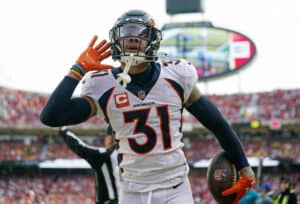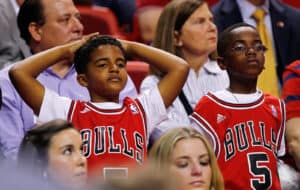Before taking the NBA by storm in early October, Victor Wembanyama and the Metropolitans 92 arrived in Henderson, Nevada to face off against the G-League Ignite. The marquee matchup pitted Ignite point guard and projected top 3 pick in the 2023 NBA Draft, Scoot Henderson, against defensive juggernaut Bilal Coulibaly and the 7’4” absurdly talented “Wemby”. The game did not disappoint, setting twitter and major television networks ablaze with current players and pundits weighing in on the NBA’s exciting potential. Lebron likened Victor Wembanyama to a 2k create a player, while Sam Vecenie, a writer at The Athletic, titled the contest as “the best NBA draft prospect game of the century.” Even with the game’s major draft implications and online fanfare, the Tuesday night matchup at Dollar Loan Arena hardly drew a crowd. NBA executives teemed around trying to catch a glimpse of the future stars, but otherwise no one came.
Despite the teams’ intrigue, the G-League Ignite program is now being shut down by Adam Silver and the NBA for reassessment. The shutdown comes amidst the arrival of the NCAA’s “Name, Image, and Likeness” program, in which college athletes are now able to monetize their success. The NBA started the Ignite in hopes of developing young talent, while giving “elite” high school players an option to become paid professionals, forgoing college or playing overseas. They were offered negotiable select contracts starting at a whopping $125,000 per season, compared to the average G-League contract of just over $40,000 per season. Seem unfair? Jalen Green, a member of the 2022-23 Ignite, was the entire league’s highest paid player, raking in $500,000 in his lone year with the team. While these opportunities did entice young talent to join the team over the four-year duration, the program struggled to win games, but more importantly, deliver a product that the NBA could stand behind long term.
In the 2023-24 season, the G-League Ignite had an average age of 25 years old, the same as the rest of the league. Looking deeper into the teams’ construction however, there lie some clues as to why the team could not compete. For one, the roster shows a complete lack of parity. They not only sported the two oldest players in the league in Jeremy Pargo and Norris Cole, but out of the top twenty youngest players, seven of them belonged to the Ignite. According to Ignite head coach Jason Hart in an interview with Switch Cultures, the league has gotten more competitive since he was hired in 2021. Upon his arrival, many G-League roster spots were still NBA journeymen giving it their last shot to find a home in the NBA. Flash forward to today and rosters have an entirely different complexion.
For starters, each team is allowed three 2-way players, who rotate back forth between the G-League and NBA. Additionally, the league has a growing populous of youth, who may not have gelled with their first team and are now looking for another chance. And lastly, lottery picks are taking up roster spots in the G-League, which creates even more competition. Instead of league outcasts and has-beens, teams are essentially being built by the NBA front offices. It comes to no surprise that a team of teenagers and players past their prime were beaten by at least 20 points, 17 times this past year, including a 60-point blowout against the Salt Lake City Stars. This year, the Stars were led by players like Micah Potter, Jason Preston and Johnny Juzang, all of whom have seen meaningful minutes in the NBA. The team also boasted 1st round and lottery picks Brice Sensabaugh and Taylor Hendricks, players handpicked by Jazz GM, Danny Ainge in the 2023 NBA draft.
In theory, Ignite’s vision in creating a team with the perfect blend of wily veterans who understand the grind, with hungry young players looking for an opportunity to make an NBA team makes sense. It provides youngsters with real-life examples of professionalism in live action and gives older players a unique opportunity to become mentors. Establishing a team identity and culture, teaching lessons on discipline, as well as having a guide as a young player can be incredibly important. Unfortunately, the competitive league did not wait around for these honest intentions to run its’ course. The 2023-24 team ended with a dismal 2 and 32 record this year, bringing their record to 27 and 66 since 2020. Young players being humbled by tough losses can create a positive environment for growth as a person, but getting dismantled game after game is completely different. And it is certainly not a product the NBA was proud of.
One small silver lining that the G-League Ignite program has had success in over the past few years is getting players drafted. Since the team launched in 2020, ten players have been drafted to the NBA, with at least three more projected this year. Players like Jalen Green, Dyson Daniels, and Jonathan Kuminga have all been contributors in their short NBA careers so far, although it took a fair amount of time. This slow development is yet another problematic stone to be flipped over. Jalen Green, most successful player from the Ignite program thus far, has only recently blossomed as a top scorer on the Houston Rockets. Jonathan Kuminga, widely known as one of the most athletic players in the NBA, until this year, has struggled to carve out a role on an average team. It would be fair to debate Steve Kerr’s usage of the budding star, but the fact is that Kuminga could not figure out how to stay on the court. Several other players’ journeys, like MarJon Beauchamp, Jaden Hardy, and even Scoot Henderson read the same way.
A team that was supposed to prepare young players for the NBA, did not prepare them. The problem is not a shortage of talent either, but in how these players are using their skillset to contribute to winning basketball. And while we discuss the importance of winning basketball, if getting to the league as a member of the Ignite is not a barrier, why is winning games even important? From a player’s perspective, the only reason to sign the contract is to gain exposure and get drafted. Sounds a lot like AAU, doesn’t it? When half the crowd is filled with NBA scouts and executives, it generates bad habits among players, more motivated to show off their individual skill as opposed to what they can bring to a team. Furthermore, the Ignite have a target on their back, which makes winning even tougher. Spoiled with a state-of-the-art stadium, 6-figure contracts, and players deemed as “elite,” by NBA standards, are always going to get the best effort from G-Leaguers, still desperate with NBA aspirations.
The failure to create a successful program in training young talent echoes the primary issues of basketball development in the United States today. Putting an emphasis on skill development and “making the right plays” leads to winning basketball. More and more of the NBA’s best players are foreign born, which is no fluke. Guys like Luka Doncic and Nikola Jokic are special players, but they do not come out of nowhere. Their games are built around intellect and footwork, not athletic ability. They were taught to play this way. Other countries have figured out how to implement valuable skills that benefit the team, not the individual. With that being said, the talent in the United States has never been higher and the NBA’s resources are plentiful. The pressure is on now on Adam Silver to create an environment for the best and brightest to flourish in today’s NBA.
Photo Credits to: Sporting News
Check out my instagram @mrb_asketball33






